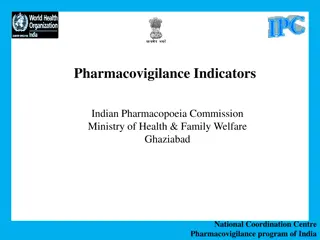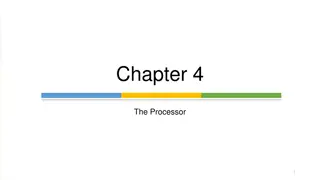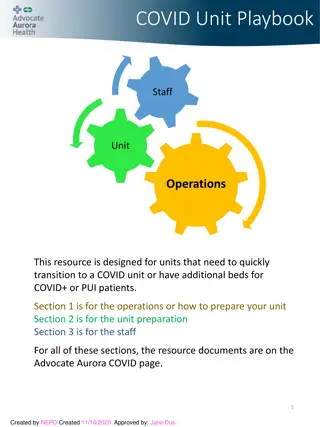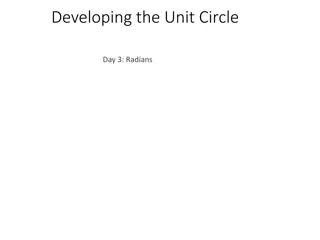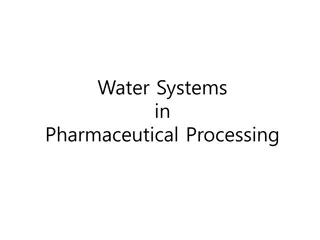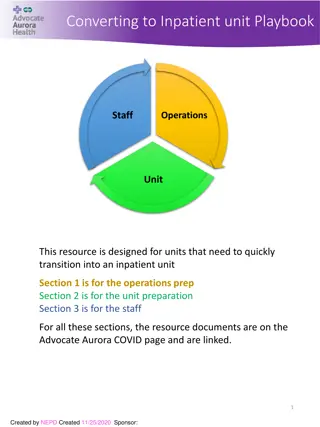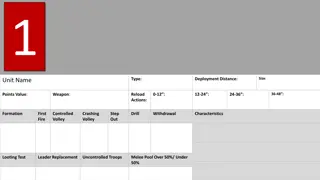Unit I Pharmacopoeia
Pharmacopoeia is a crucial book that sets standards and quality indices for pharmaceutical preparations, raw materials, and drugs. It is an official legislation of each country and plays a vital role in ensuring the quality and safety of medications. The history of Pharmacopoeia, including the first USP and BP editions, and the development of the Indian Pharmacopoeia, highlights its significance in the pharmaceutical industry.
Download Presentation

Please find below an Image/Link to download the presentation.
The content on the website is provided AS IS for your information and personal use only. It may not be sold, licensed, or shared on other websites without obtaining consent from the author.If you encounter any issues during the download, it is possible that the publisher has removed the file from their server.
You are allowed to download the files provided on this website for personal or commercial use, subject to the condition that they are used lawfully. All files are the property of their respective owners.
The content on the website is provided AS IS for your information and personal use only. It may not be sold, licensed, or shared on other websites without obtaining consent from the author.
E N D
Presentation Transcript
Unit I Pharmacopoeia Dr. Meenakshi Gupta Senior Assistant Professor University Institute of Pharmacy C. S. J. M. University Kanpur U.P
PHARMACOPOEIA : Each country has legislation on pharmaceutical preparations which sets a standards and required quality indices for medicament, raw materials and preparations employed in the manufacture of drugs. These regulations are presented in separate articles. General and specific matters relating to individual drugs are published in the form of a book called a Pharmacopoeia
PHARMACOPOEIA : Derived from Greek word Pharmakon means drug and Poiea means to make. Pharmacopoeia is a book containing directions for the identification of samples and the preparation of compound medicines, and published by the authority of a government or a medical or pharmaceutical society. Pharmacopoeia is a legislation (Law/enacting Law) of a nation which sets standards and mandatory quality indices for drugs, raw materials used to prepare them and various pharmaceutical preparations.
PHARMACOPOEIA : It is a legal and official book issued by recognized authorities usually appointed by Government of each country. It comprises list of pharmaceutical substances, formulae along with their description and standards. List of Pharmacopeias: a) Argentine b) Austrian c) Belgian d) Brazilian e) British f) Chinese g) Egyptian h) European i) French j) German k) Hungarian l) Indian m) International n) Italian o) Japanese p) Yugoslavian q) Mexican r) Netherlands s) Nordic t) Polish u) Portuguese v) Rumanian w) Russian x) Spanish y) Turkish z) United state.
History of Pharmacopoeia On 15th December 1820, the first United State Pharmacopoeia (U.S.P) was released. In 1864, the first British Pharmacopoeia (B.P) was published with inclusion of monographs on benzoic acid, gallic acid, tartaric acid, tannic acid, camphor, lactose, sucrose and seven alkaloids along with their salts
History of Indian Pharmacopoeia British Pharmacopoeia was utilized as the official book of standards in India before independence. The actual process of publishing the first Indian Pharmacopoeia started in the year 1944 under the chairmanship of Col. R. N. Chopra. The Indian Pharmacopoeia list was first published in the year 1946 by Government of India Committee under chairmanship of Sir R. N. Chopra along with other nine members prepared The Indian Pharmacopeial list It was prepared by Dept. of Health, Govt. of India, Delhi in 1946.
History of Indian Pharmacopoeia In 1948 Government of India appointed an Indian Pharmacopeia committee for preparing Pharmacopeia of India and established a central Indian Pharmacopoeia Laboratory at Ghaziabad, Uttar Pradesh to keep it up to date. Tenure of this committee was five years. Indian Pharmacopeia committee under chairmanship of Dr. B. N. Ghosh Published First edition of IP in 1955. The Indian Pharmacopoeia is published in fulfillment of the requirements of the Drugs and Cosmetics act, 1940 and rules there under. Supplement for first edition published in the year 1960. This Pharmacopoeia contained both western and traditional system drugs commonly used in India. of Indian Pharmacopoeia was
History of Indian Pharmacopoeia The drugs and cosmetics act 1940 stated that the Indian Pharmacopoeia is the book of standards for drugs included therein and the standards as included in the Indian Pharmacopoeia would be official. If considered necessary, these standards can be amended and the secretary of the Indian Pharmacopoeia committee is authorized to issue such amendments.
Second edition of IP was published in 1966 under the chairmanship of Dr. B. Mukkerji. Official titles of monographs given in English. Dose were expressed in Metric system. Formulations of the drugs were given immediately after the monograph of drugs. 274 monographs from IP 55 & their supplement were deleted. 93 new monographs were added. Supplement to this edition was published in 1975. 126 new monographs have been included & 250 monographs have been amended. Cholera vaccine has been deleted.
Third edition of IP was published in 1985 with two volumes & nine appendices. 261 new monographs have been added. 450 monographs were deleted. Addendum I to IP was published in 1989 were 46 new monographs added and 126 amended. Addendum II was published in 1991 were 62 new monographs added and 110 amended. Fourth edition of IP was published in 1996 under the chairmanship of Dr. Nityanand. It covered 1149 monographs and 123 appendices. It includes 294 new monographs & 110 monographs have been deleted. Addendum I has been made effective from 31st December 2000 were 42 new monographs have been added. Addendum II has been made effective from 30th June 2003 were 19 new monographs have been added. The veterinary supplement to IP 1996 contains 208 monographs & four appendices.
Fifth edition of IP was published in 2007 & addendum to this edition was published in 2008. IP 2007 is presented in Three Volumes. Volume One contains general notices & general chapters. Volume Two & Three contains general monographs on drug substances , dosage forms & Pharmaceutical aids. 6th edition of IP is published in 2010 by the Indian Pharmacopoeia Commission (IPC) Ghaziabad and presented in three volumes. Volume I contains the Notices, Preface, the Structure of the IPC, Acknowledgements, Introduction, and the General Chapters. Volume II contains the General Notice, General Monographs on Dosage Forms and Monographs on drug substances, dosage forms and pharmaceutical aids (A to M). Volume III contains Monographs on drug substances, dosage forms and pharmaceutical aids (N to Z). Followed by Monographs on Vaccines and Immunosera for Human use, Herbs and Herbal products, Blood and blood- related products, Biotechnology products and Veterinary products.
The seventh edition of the Indian Pharmacopoeia (IP 2014) is published by the Indian Pharmacopoeia Commission (IPC) on behalf of the Government of India, Ministry of Health & Family Welfare. The Indian Pharmacopoeia 2014 is presented in four volumes. The scope of the Pharmacopoeia has been extended to include additional anticancer drugs & antiretroviral drugs and formulations, products of biotechnology, indigenous herbs and herbal products, veterinary vaccines. The IP 2014 incorporates 2550 monographs of drugs out of which 577 are new monographs consisting of APIs, excipients, dosage forms and herbal products etc.
The Eight edition of Indian Pharmacopoeia was published in 2018 by the IPC on behalf of the Ministry of Health and Family Welfare, Government of India. Incorporating with 4 volume. 220 New monographs 170 New chemical monographs 49 API , 64 Formulation , 53 Fixed dose formulations , 02 Excipients , 02 Antibiotics 15 New herbs and Herbal products monographs , 03 New Radiopharmaceutical monographs. , 14 New veterinary Non-biological monographs. monographs 02 Vaccines and Immunosera for human use derived therapeutic products. 10 Blood and Blood related products. 18 New Biological 06 Biotechnology
Monograph monographs are descriptions of pharmaceutical preparations. It is a complete description of a specific pharmaceutical, which includes chemical formulae, atomic and molecular weight, definition, statement of content, category, dose, usual strength, description, solubility, identification tests, assay, other test, limits of impurities, quantities, and conditions for storage. The appendices include standards for apparatus, reagents and solutions, indicators, reference substances, test animals, calculation of results, other chemicals techniques, processes etc. of the concerned pharmaceuticals.
Drug Compendia The drug compendia (collection of information) are classified as: (i) Official compendia (ii)Non-official compendia Non-official Compendia The book other than official drug compendia which are used as secondary reference sources for drugs and other related substances are known as non-official drug compendia. e.g. Merck Index, Extra Pharmacopoeia (Martindale), United States Dispensatory etc
British Pharmacopoeia First edition of BP was published in 1864 & consist of two sections Part I: Materia Medica Part II: Preparation & compounds Second edition of BP was published in 1867 Third edition of BP was published in 1885 Fourth edition of BP was published in 1898 Fifth edition of BP was published in 1914 Eighth edition of BP was published in 1953: Titles of drugs & preparations were in English instead of Latin and metric system.






